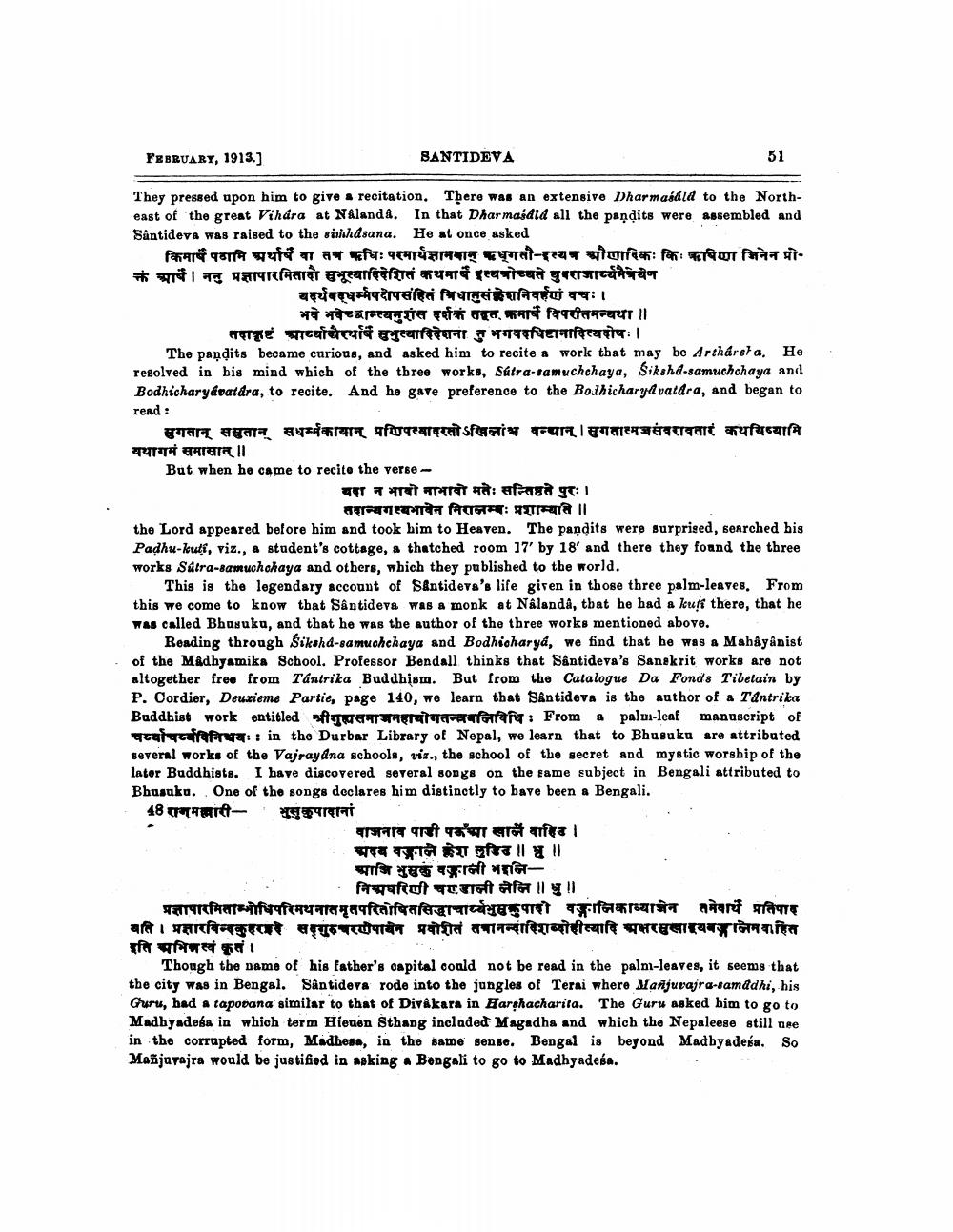________________
SANTIDEVA
FEBRUARY, 1913.]
They pressed upon him to give a recitation. There was an extensive Dharmasala to the Northeast of the great Vihara at Nâlandâ. In that Dharmasdid all the pandits were assembled and Sântideva was raised to the simhdsana. He at once asked किमार्थ पठानि अर्थार्षं वा तत्र ऋषिः परमार्थज्ञानवान् ऋध्गतौ इत्यत्र श्रीणादिकः किः ऋषिणा जिनेन प्रोतं । ननु प्रज्ञापारमितादौ सुभूत्यादिदेशितं कथमार्षे इत्यत्रोच्यते युबराजार्थ्यमैत्रेयेण
बहधम्मैपदोपसंहितं
51
निवर्तयां वचः।
भवे भवेच्छान्त्यनुशंस दर्शकं तद्वत क्रमार्षे विपरीतमन्यथा ॥ तदाकृष्टं आर्य्याद्यैरर्यार्षे सुभुत्यादिदेशना तु भगवदधिष्टानादित्यदोषः ।
The pandits became curious, and asked him to recite a work that may be Artharsha, He resolved in his mind which of the three works, Sútra-samuchchaya, Sikshd-samuchchaya and Bodhicharyavatára, to recite. And he gave preference to the Bodhicharyavatara, and began to _rend :
सुगतान् ससुतान् सधर्म्मकायान् प्रणिपत्यादरतोऽखिलांच वन्द्यान् | सुगतात्मजसंवरावतारं कथयिष्यामि यथागमं समासात् ॥
But when he came to recite the verse
यदा न भावो नाभावो मतेः सन्तिष्ठते पुरः । तदान्यगत्यभावेन निरालम्बः प्रशाम्यति ॥
the Lord appeared before him and took him to Heaven. The pandits were surprised, searched his Padhu-kauti, viz., a student's cottage, a thatched room 17' by 18 ́ and there they found the three works Sátra-samuchchaya and others, which they published to the world.
This is the legendary account of Santideva's life given in those three palm-leaves. From this we come to know that Sântideva was a monk at Nâlandâ, that he had a kufi there, that he was called Bhusuku, and that he was the author of the three works mentioned above.
Reading through Sikshd-samuchchaya and Bodhicharya, we find that he was a Mahâyânist of the Madhyamika School. Professor Bendall thinks that Sântideva's Sanskrit works are not altogether free from Tántrika Buddhism. But from the Catalogue Da Fonds Tibetain by P. Cordier, Deurieme Partie, page 140, we learn that Sántideva is the author of a Tantrica Buddhist work entitled श्रीगुह्यसमा जमहायोगतन्त्र बनिविधि: From a palus-leaf manuscript of qeatqcdfafrua:: in the Durbar Library of Nepal, we learn that to Bhusuku are attributed several works of the Vajraydna schools, viz., the school of the secret and mystic worship of the later Buddhists. I have discovered several songs on the same subject in Bengali attributed to Bhusuku. One of the songs declares him distinctly to have been a Bengali. 48 राज मल्लारी
वाजनाव पाडी पऊँग्रा खालें वाहिङ ।
अदब वङ्गाले केश लुडिड ॥ ध्रु ॥ आज मुखकं वङ्गाली भनिनिअरिणी चण्डाली लेनि ॥ भु !
प्रज्ञापारमिताम्भोधिपरिमथनात मृत परितोषित सिद्धाचार्य्यभुचक्रपादो वङ्गानिकाव्याजेन तमेवार्थे प्रतिपाद जति प्रशारविन्दकुहरहरे सगुरुचरपावेन प्रयोशत समानत्वाविशव्याही व्यापि बङ्गजिगवा. हिव इति प्रभिनत्वं कृतं ।
Though the name of his father's capital could not be read in the palm-leaves, it seems that the city was in Bengal. Sântideva rode into the jungles of Terai where Mañjuvajra-samadhi, his Guru, had a tapovana similar to that of Divakara in Harshacharita. The Guru asked him to go to Madhyadesa in which term Hieuen Sthang included Magadha and which the Nepaleese still nee in the corrupted form, Madhess, in the same sense. Bengal is beyond Madhyadeśa. So Mañjuvajra would be justified in asking a Bengali to go to Madhyadeśa.




